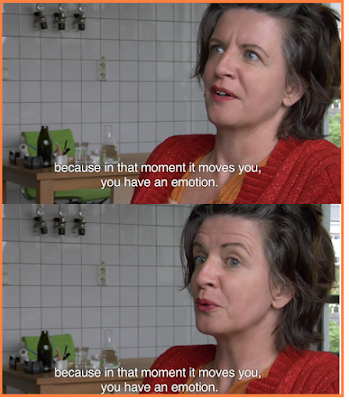Dirt Devil by Karim Rashid
Karim Rashid works for the
“techno-organic world.” As a teenager, he owned a Claritone stereo radio and a
Braun alarm clock and through his teenage angst, looking at them alone in his
room brought a sense of comfort. He
calls our time the “third technological revolution.” To him, our living room
furniture is like a kitsch stage prop. “When I get up from my laptop and my
iPod, do I get into a horse and carriage? No.”
 |
| Claritone stereo similar to Karim Rashid's. |
According
to Andrew Blauvelt, the design concept has three layers. First form begets
form, the formal logic of form. Then
come symbols and symbolism, the cultural symbols. From that comes the contextual symbolism of
making coffee, for instance, the bigger scenario of the human-object
relationship. The little rituals define
the fork and knife. The vacuum cleaners
from Dirt Devil and Dyson extended the horizons for a single-use product into
designer goods for display. Ultimately, the Roomba programmable robot vacuum
allowed an undreamed of level of hacking as user interaction.
Alice Rawsthorn of the International Herald Tribune points out that if you were a Martian and you came to Earth,
you could pick up a spoon or a chair and pretty much get a feel for their
purpose. Now, the digital age removes
that. Objects can take any shape. This leads to tensions and conflicts in
design.
But objects do not take just any shape. Some seem intractably wedded to their pasts.
Three principals from IDEO of Palo Alto shared a common theme in their different experiences of design. "I inherited my father’s
leather briefcase and it got better with time and I look to passing it on. I look to designing things for wearing in
versus wearing out. ... I designed the case for
the GRiD “Compass” computer in 1987, the first laptop. When I got it home I realized that the
beautiful case and clever latches were irrelevant to the user experience, so I
came to study software interfaces. ... "
 |
| "... because in that moment it moves you, you have an emotion" -- Hella Jongerius |
Rob Walker of the New York Times Magazine asks rhetoically, when the hurricane
is coming and you have twenty minutes to pack, what do you grab? Not the object
that got a great review in some design magazine, but the object that means the
most to you.
Paola Antonelli insists
that “democritization of design is an empty slogan.” According to Paola
Antonelli, “design takes revolutions and progress and makes it into objects
that we can use.”
Speaking of his work on the MacBook Air and MacBook Pro, Jonathan Ive says that the curse
of being a designer is always looking at everything and wondering “why does it
have to be that way and not some other way?”
Ad hoc design: wine cork as doorstop
Ad hoc design: section of plastic cup as bicycle fender
I want things that do not
exist, that you cannot go out and buy, what is going to happen, not what has
happened. – Marc Newson.
 |
| Within Karim Rashid's apartment |
ALSO ON NECESSARY FACTS






No comments:
Post a Comment
Note: Only a member of this blog may post a comment.